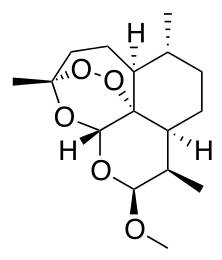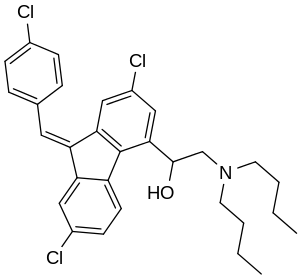Artemether and lumefantrine fall in a class of medications called antimalarials. It works by killing the organisms that cause malaria.
Lumefantrine is used to treat acute uncomplicated malaria. It is administered in combination with artemether for improved efficacy. This combination therapy exerts its effects against the erythrocytic stages of Plasmodium spp. and may be used to treat infections caused by P. falciparum and unidentified Plasmodium species, including infections acquired in chloroquine-resistant areas. It can also be used for infections acquired in areas known to have parasites that are multidrug-resistant.
Artemether, like other artemisinin-derived compounds, acts quickly to rapidly reduce the parasite burden, while lumefantrine serves as a longer-acting agent to eliminate remaining parasites and prevent recrudescence.
Advantage over Chloroquine plus Sulfadoxine Pyrimethamine
•Antimalarial treatment with artemether & lumefantrine involves the heme mediated decomposition of the Endoperoxide Bridge to produce carbon centered free radicals. This involvment of heme explains why this drug combintion is selectively toxic to malarial parasites compared to chloroquine plus sulfadoxine pyrimethamine.
•The parasite clearance time is significantly shorter with artemether lumefantrine (2.08 days, 95% Cl) than chloroquine plus sulfadoxine pyrimethamine (2.9 days, 95% cl).
•The mean fever clearance time is also significantly shorter with artemether-lumefantrine(23.1h,95% Cl) compared with chloroquine plus sulfadoxine -pyrimethamine(40.2 h,95%cl).
•Moreover, gametocyte carriage is lower with artemether-lumefantrine by day 28,day 14 and day 7as compared with chloroquine plus sulfadoxine pyrimethamine.
Advantage over Amodiaquine plus Artesunate
•There are fewer parasitological failures accomplished in artemether & lumefantrine combined therapy as compared to amodiaquine plus artesunate.
•Moreover, significantly lowered gametocyte carriage with artemether- lumefantrine as compared to amodiaquine plus artisunate makes artemether lumefantrine combination of better choice.
•Fever and parasite clearance times are significantly shorter with artemether as compared to amodiaquine plus artisunate.
MK Medicine is a leading pcd franchise provider, contract manufacturer and hospital supplier of WHO-GMP certified Artemether IP 80 mg Lumefantrine USP 480 mg Tablet
If overdose is suspected, contact a poison control center or emergency room immediately. Symptoms of overdose may include: severe dizziness, fainting, slow/irregular heartbeat
Do not share this medication with others
Laboratory and/or medical tests (such as EKG) should be performed at the start of treatment and periodically to monitor your progress or check for side effects. Consult your doctor for more details
If you miss a dose, take it as soon as you remember. If it is near the time of the next dose, skip the missed dose and resume your usual dosing schedule. Do not double the dose to catch up
Do not take this medicine, if
you are allergic to any ingredient in this medicine
you have low blood potassium or magnesium levels, a very slow heartbeat, or severe heart problems
you have a history of a certain type of irregular heartbeat (eg, QT prolongation) or you take any medicine that may increase the risk of this type of irregular heartbeat.
a family member has a history of QT prolongation or sudden death.
you have taken or will be taking halofantrine within 30 days before or after using this medicine.
Contact your doctor or health care provider right away if any of these apply to you.
Artemether and lumefantrine may cause side effects. Tell your doctor if any of these symptoms are severe or do not go away:
Headache
Dizziness
Weakness
Muscle or joint pain
Tiredness
Difficulty falling asleep or staying asleep
Vomiting
Loss of appetite
Fever
Chills
4 tablets as a single initial dose, 4 tablets again after 8 h, and then 4 tablets twice daily (morning and evening) for the following 2 days (total course of 24 tablets).
Disclaimer:To be taken only after consulting with the doctor.
PHARMACOLOGY
Mechanism of Action
The combination product contains artemether and lumefantrine. Both are blood schizontocides.
Artemether is a semisynthetic chiral acetal derivative of artemisinin. It interferes with parasite transport proteins, produces disruption of mitochondrial function, inhibits angiogenesis, and modulates host immune function. Artemether and its active metabolite have been estimated to reduce parasite biomass by approximately 10,000-fold per reproductive cycle (every 2 days).
Lumefantrine is a racemic mixture of a synthetic fluorine derivative and is structurally related to quinine, mefloquine, and halofantrine. It interferes with the conversion of heme, the toxic intermediate step produced during hemoglobin break-down, to non-toxic hemozoin. Accumulation of heme and free radicals results in parasite death.
Pharmacokinetics
Absorption: Following oral administration, artemether is absorbed with peak plasma concentrations reached about 2 hours after dosing. Absorption of lumefantrine, a highly lipophilic compound, starts after a lag-time of up to 2 hours, with peak plasma concentrations about 6 to 8 hours after administration. Food enhances the absorption of both artemether and lumefantrine.
Distribution: Artemether, dihydroartemisinin (active form of artemether) and lumefantrine are both highly bound to human serum proteins.
Biotransformation: In human liver microsomes and recombinant CYP450 enzymes, the metabolism of artemether was catalyzed predominantly by CYP3A4/5. Dihydroartemisinin (DHA) is an active metabolite of artemether. Lumefantrine in human liver microsomes and in recombinant CYP450 enzymes was metabolized mainly by CYP3A4 to desbutyl-lumefantrine.
The systemic exposure to the metabolite desbutyl-lumefantrine was less than 1% of the exposure to the parent compound.
Elimination: Artemether and DHA are cleared from plasma with an elimination half-life of about 2 hours. Lumefantrine is eliminated more slowly, with an elimination half-life of 3-6 days.
INTERACTIONS
• Some antimalarial drugs (such as halofantrine) should not be used within one month of treatment with artemether/lumefantrine.
• Antiarrhythmic drugs (such as amiodarone, sotalol, procainamide, disopyramide), antipsychotics (such as pimozide, ziprasidone), macrolide antibiotics (such as erythromycin), quinolone antibiotics (such as ciprofloxacin, moxifloxacin).
• Medications which can affect the removal of artemether/lumefantrine from your body, includes, some anti-seizure drugs (such as carbamazepine, phenobarbital, phenytoin), azole antifungals (such as ketoconazole, itraconazole), mefloquine, HIV NNRTIs (such as delavirdine, efavirenz), HIV protease inhibitors (such as nelfinavir, ritonavir), rifamycins (such as rifabutin, rifampin), St. John‚s wort
• This medication can speed up or slow down the removal of other medications from your body,including, flecainide, certain beta blockers such as metoprolol, certain tricyclic antidepressants (such as amitriptyline and imipramine)
• This medication may decrease the effectiveness of hormonal birth control such as pills, patch, or ring.
• Take tablet by mouth with food
• If you are unable to swallow the tablet, it may be crushed and mixed with a small amount of water (1 or 2 teaspoons) in a clean container. Swallow the mixture immediately; then rinse the container with more water and swallow to be sure you receive the entire dose. Follow with food or drink (eg, milk, formula, pudding, broth, porridge). Do not store the mixture for future use
• Do not eat grapefruit or drink grapefruit juice while you use this medicine
• If you vomit within 1 hour after taking tablet, take another dose. If you vomit the repeat dose, contact your doctor
• Continue to take medicine even if you feel well. Do not miss any doses
• If you miss a dose of tablet, contact your doctor
• If you stop taking medicine too soon or skip doses, your infection may not be completely treated.
Ask your health care provider for any other query about how to use this medicine.
Almither - AL Tablets contain a fixed combination of 2 antimalarial active ingredients, artemether, an artemisinin derivative, and lumefantrine. Both components are blood schizontocides. The chemical name of artemether is (3R,5aS,6R,8aS,9R,10S,12R,12aR)-10-methoxy-3,6,9-trimethyldecahydro-3,12-epoxypyrano[4,3-j]-1,2- benzodioxepine. Artemether is a white, crystalline powder that is freely soluble in acetone, soluble in methanol and ethanol, and practically insoluble in water. It has the empirical formula C16H26O5 with a molecular weight of 298.4, and the following structural formula:

The chemical name of lumefantrine is (1RS)-2-(dibutylamino)-1-{(9Z)-2,7-dichloro-9-[(4- chlorophenyl)methylene]-9H-fluorene-4-yl}ethanol. Lumefantrine is a yellow, crystalline powder that is freely soluble in N,N-dimethylformamide, chloroform, and ethyl acetate; soluble in dichloromethane; slightly soluble in ethanol and methanol; and insoluble in water. It has the empirical formula C30H32Cl3NO with a molecular weight of 528.9, and the following structural formula:

Important Notice:- The Database is still under development and may contain inaccuracies. It is not intended as a substitute for the expertise and judgement of your physician, pharmacist or other healthcare professional. It should not be construed to indicate that the use of any medication in any country is safe, appropriate or effective for you. Consult with your healthcare professional before taking any medication.


Quinine Sulphate 100 mg Tablet